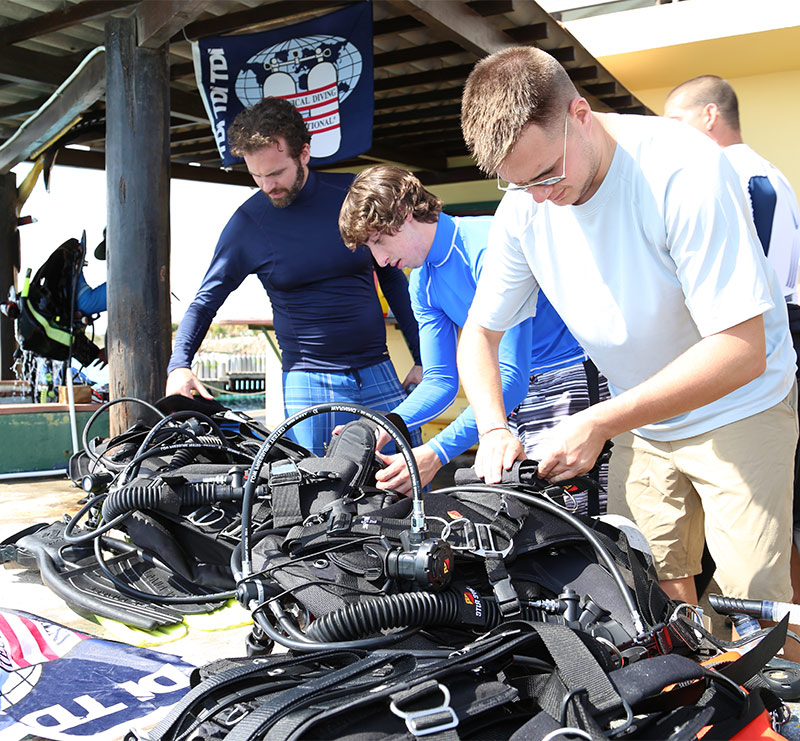Effective Preparation for Every Dive
by Rob Bradish:

So often when thinking of dive preparation, the diver may limit his or her self to pre-dive gear packing and the planning discussion that goes on during the ride to the dive site. However, if someone is to be truly prepared, there is much to do long before the day of the dive. In fact, when examining preparation, there seems to be three clear keys to Effective Preparation for Every Dive.
From a personal perspective, the first key has to be mental preparation. Preparation of this type extends far beyond using a computer to pre-plan your time at depth 50 minutes from now, and requires some steps to effectively get there. For example, the diver must recognize his or her own capabilities. Is the dive being considered within the realm of the diver’s training? Is the site a new site or one dove many times in the past? Does one have all of the appropriate skills, tools, and techniques to complete the dive safely? Participants in some activities are encouraged to visualize, a process of mentally walking through the event, attempting to identify possible challenges or areas where an incident may occur. The night before a dive, visualization can help one determine choices for gear while packing. On the ride to the site, visualization allows the diver to prepare more directly, while witnessing environmental issues that will likely affect the dive. Without this kind of mental preparation, a diver cannot just say they are ready to dive on any given day.
Few people look forward to loading and unloading heavy gear. Hauling tanks back and forth from a dive vessel, or climbing back on board a boat using a dive ladder can require a lot of effort, making physical preparation the second key. While much of that preparation should occur months and weeks before a dive, through exercise, skills practice, and healthy habits, it continues right up to the day of the dive. Frequently, a dive actually begins with a drive to the departure location, either the morning of or the night before. Eating a healthy meal, hydrating effectively, and arriving well-rested are all part of physical preparation. The fact is, staying up until 2 am the night before drinking beers with friends might seem like a great start to a weekend, but not to a weekend of diving. Knowing such activities lead to the increasing probability of DCS incidents, it just doesn’t make sense. Knowing there is another diver, who may depend on his or her buddy, makes it even more important to be able to perform at optimum levels.
Obviously, gear preparation is something that cannot be overlooked and it is our third key. Scuba diving is called a gear intensive sport for a reason. The fact is people do not have gills, and if we are to enjoy what the marine environment has to offer, then equipping ourselves to exist in that environment is important. Annual maintenance is vital to safe diving, if only to insure the life support equipment is performing to standard. Trying to verify gear functionality on the way to a dive site however, is not preparation. Many find it effective to “flat diver” the gear before packing. Essentially, one would lay everything out and make sure that everything needed for the day’s dive is ready. In contrast, the only way to verify regulator and buoyancy compensator functionality is to assemble and test each delivery and exhaust point. Batteries and bulbs need to be fresh in lights and computers. Surface marker buoys and lift bags should be clean and ready to deploy. Finally, is the “Save-a-Dive” kit adequate to actually save the dive? Will the spare mask and fin straps work properly with the gear being packed?
While “plan the dive, dive the plan” has been a part of the diver mantra since the early days, it is important to note that such planning begins long before the day of the dive. Effective mental preparation, through training, research, and visualization are all key components. Physical preparation with effective exercise and living habits are also key. Finally, equipment preparation, not only in maintenance of equipment but in its proper selection for its anticipated use, is the final key. Only with all three keys, can we effectively unlock the “three lock box” of dive planning. Only at this point can the diver effectively determine the goals, depth, and duration for the dive. Even the seemingly simple tasks of entry and exit need to be planned.
Finally, never forget the post dive plan! It would be a shame to go through all of that preparation and planning, failing to include a stop at the local tiki hut for a meal, libations, the telling of lies, and sharing of discoveries!!
Safe Diving!
Rob Bradish, who refers to himself as “a recreational diver with technical Interests”, has been diving since 1981, crossing over to “the Dark Side” as an instructor with SDI/TDI. He works as an independent contractor through Air Hogs Scuba, of Garner, North Carolina and Blackbeard Scuba of Southport, North Carolina.


Lascia un Commento
Vuoi partecipare alla discussione?Sentitevi liberi di contribuire!